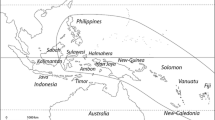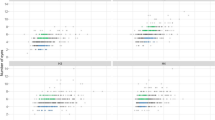Abstract
Greening of the tuber skin is an undesirable defect in fresh and processed potato. Tubers of 92 Solanum microdontum families represented by 12 individuals each were generated in the winter greenhouse in 2009–2010. These were evaluated in two trials of family bulks after 4 days of exposure to 200 ft candles of fluorescent white light at room temperature, similar to that observed in local grocery stores, and according to preliminary tests, able to turn some microdontum tubers very green. A qualitative score of green (G) or white (W) was assigned to each tuber. Tubers of about 10 % of families were scored as mostly W. In comparison, when 185 named Solanum tuberosum cultivars were illuminated in the same way, none from Europe or North America scored W. Two replicates of G and W individual tubers were selected from a variety of microdontum families and planted to create a new clonal generation of tubers. Those second generation daughter tubers showed a response to illumination which was consistent with that of the previous clonal generation. Finally, W and G clones were selected and mated. All GxG hybrids were uniformly G, but only three WxW crosses produced families that were nearly uniformly W. Thus some selections were shown to have consistent non-greening over trials spaced in time, over a clonal generation, and, when crossed together produced pure non-greening progeny. On the other hand, several very green selections similarly were consistently very green over time, clonal regeneration, and intermating. Tests of tuber tissue for glycoalkaloids showed that some illuminated clones neither green nor accumulate glycoalkaloids. These materials would make good models for further study of inheritance and physiology of the greening trait, and for breeding.
Resumen
El verdeo de la piel del tubérculo es un defecto indeseable en la papa fresca y para procesamiento. En invernadero en invierno de 2009–2010, se generaron tubérculos de 92 familias de Solanum microdontum representadas por 12 individuos cada una. Se evaluaron en dos ensayos en grupos de familia después de cuatro días de exposición a 200 pies candela de luz blanca fluorescente a temperatura ambiente, similar a lo que se observa en las tiendas locales de abarrotes, y de acuerdo a pruebas preliminares, capaces de mucho enverdecimiento de algunos tubérculos de microdontum. Se asignó a cada tubérculo una calificación cualitativa de verde (G) o blanca (W). Tubérculos de cerca del 10 % de las familias tuvieron calificaciones mayormente W. En comparación, cuando se iluminaron de la misma manera 185 variedades con nombre de Solanum tuberosum, ninguna de Europa o Norteamérica tuvo calificación de W. Se seleccionaron dos repeticiones de tubérculos individuales de G y W de una amplitud de familias de microdontum y se plantaron para crear una nueva generación clonal de tubérculos. Los tubérculos descendientes de esa segunda generación mostraron una respuesta a la iluminación consistente con la generación clonal previa. Finalmente, se seleccionaron y cruzaron clones W y G. Todos los híbridos GxG fueron G uniformemente, pero solamente tres cruzas WxW produjeron familias que fueron cercanamente uniformes W. De aquí que algunas selecciones mostraron tener no enverdecimiento consistente a lo largo de los ensayos espaciados en el tiempo, sobre una generación clonal, y cuando se cruzaron juntos produjeron progenie pura de no enverdecimiento. Por otro lado, algunas selecciones muy verdes similarmente fueron consistentemente muy verdes en el tiempo, en regeneración clonal y en intercruzamientos. Las pruebas de tejido de tubérculo para glicoalcaloides mostraron que algunos clones iluminados no se verdearon ni acumularon glicoalcaloides. Estos materiales harían buenos modelos para estudio posterior de la herencia y fisiología del carácter de enverdecimiento y para mejoramiento.


Similar content being viewed by others
References
Arteca, R.N. 1982. Calcium infiltration inhibits greening in Katahdin potatoes. Hortscience 17: 79–80.
Bamberg, J.B. 2012. Variation for tuber greening in the wild potato Solanum microdontum. American Journal of Potato Research 89: 31.
Bamberg, J.B., and A.H. del Rio. 2014. Selection and validation of an AFLP marker core collection for the wild potato Solanum microdontum. American Journal of Potato Research. doi:10.1007/s12230-013-9357-5.
Chang, Hsueh-Yuan. 2013. Light-induced glycoalkaloid and chlorophyll synthesis in potato tubers: cultivar differences and strategies for mitigation. MS thesis. UC-Davis. 85 pp.
Dao, L., and M. Friedman. 1994. Chlorophyll, chlorogenic acid, glycoalkaloid, and protease inhibitor content of fresh and green potatoes. Journal of Agricultural and Food Chemistry 42: 633–639.
Dickie, F.M. 2004. Postharvest greening and total glycoalkaloid concentration in eight varieties of specialty potatoes. MS thesis, UC-Davis. 69 pp.
Dinkins, C.L.P., and R.K.D. Peterson. 2008. A human dietary risk assessment associated with glycoalkaloid responses of potato to Colorado potato beetle defoliation. Food and Chemical Toxicology 46: 2837–2840. cites.
Edwards, J.E., and A.H. Cobb. 1997. Effect of temperature on glycoalkaloid and chlorophyll accumulation in potatoes (Solanum tuberosum L. cv. King Edward) stored at low photon flux density, including preliminary modeling using an artificial neural network. Journal of Agricultural and Food Chemistry 45: 1032–1038.
Edwards, E.J., and A.H. Cobb. 1999. The effect of prior storage on the potential of potato tubers (Solanum tuberosum L.) to accumulate glycoalkaloids and chlorophylls during light exposure, including artificial neural network modeling. Journal of the Science of Food and Agriculture 79(10): 1289–1297.
Eie, T. and H Larsen. 2012. Proceedings, eighteenth IAPRI world packaging conference. p 149–155.
Ewell, P.T., H. Fano, K.V. Raman, J. Alcazar, M. Palacios, and J. Carhuamaca. 1990. Farmer management of potato insect pests in Peru, Food systems research series no. 6, 87. Lima: International Potato Center (CIP).
Fleming, Ian. 1964. You only live twice. Signet, New American Library. 160pp. p 58.
French-Brooks, J. 2012. Reducing supply chain and consumer potato waste. WRAP (http://www.wrap.org.uk/) Research Report. 50pp.
Friedman, M. 2006. Potato glycoalkaloids and metabolites: roles in the plant and in the diet. Journal of Agricultural and Food Chemistry 54: 8655–8681.
Gonzalez, S., J.M. Huerta, S. Fernandez, A.M. Patterson, and C. Lasheras. 2008. Differences in overall mortality in the elderly may be explained by diet. Gerontology 54: 232–237.
Griffiths, D.W., M.F.B. Dale, and H. Bain. 1994. The effect of cultivar, maturity and storage on photo-induced changes in the total glycoalkaloid and cholorophyll contents of potatoes (Solanum tuberosum). Plant Science 98: 103–109.
Griffiths, D.W., H. Bain, and M.F.B. Dale. 1997. The effect of low-temperature storage on the glycoalkaloid content of potato (Solanum tuberosum) tubers. Journal of the Science of Food and Agriculture 74: 301–307.
Grunenfelder, L.A., L.O. Knowles, L.K. Hiller, and N.R. Knowles. 2006a. Glycoalkaloid development during greening of fresh market potatoes (Solanum tuberosum L.). Journal of Agricultural and Food Chemistry 54: 5847–5854.
Grunenfelder, L.A., L.K. Hiller, and N.R. Knowles. 2006b. Color indices for the assessment of chlorophyll development and greening of fresh market potatoes. Postharvest Biology and Technology 40: 73–81.
Hall, R.L. 1992. Toxicological burdens and the shifting burden of toxicology. Food Technology 46: 109–112.
Harvey, M.H., M. McMillan, M.R. Morgan, and H.W.-S. Chan. 1985. Solanidine is present in sera of healthy individuals and in amounts dependent on their dietary potato consumption. Human and Experimental Toxicology 4: 187–194.
Jakuczun, H., and E. Zimnoch-Guzowska. 2004. Inheritance of glucose content in tubers of diploid potato families. American Journal of Potato Research 81: 359–370.
Jakuczun, H., and E. Zimnoch-Guzowska. 2006. Inheritance of tuber greening under light exposure in diploid potatoes. American Journal of Potato Research 83: 211–221.
Korpan, Y.I., E.A. Nazarenko, I.V. Skryshevskaya, C. Martelet, N. Jaffrezic-Renault, and A.V. El’skaya. 2004. Potato glycoalkaloids: true safety or false sense of security? Tends in Biotechnolog 22: 147–151.
Kozukue, N., and S. Mizuno. 1990. Effect of light exposure and storage temperature on greening and glycoalkaloid content in potato tubers. Journal of the Japanese Society of Horticulatural Science 59: 673–677.
Liljemark, A., and E. Widoff. 1960. Greening and solanine development of white potatoes in various types of consumer packages. American Potato Journal 28: 589–602.
Machado, R.M.D., M.C.F. Toledo, and L.C. Garcia. 2007. Effect of light and temperature on the formation of glycoalkaloids in potato tubers. Food Control 18: 503–508.
Papathanasiou, F., S.H. Mitchell, and B.M.R. Harvey. 1998. Glycoalkaloid accumulation during tuber development of early potato cultivars. Potato Research 41: 117–125.
Parfitt, D.E., and S.J. Peloquin. 1981. The genetic basis fortuber greening in 24-chromosome potatoes. American Potato Journal 58: 299–304.
Patel, B., R. Schutte, P. Sporns, J. Doyle, L. Jewel, and R.N. Fedorak. 2002. Potato glycoalkaloids adversely affect intestinal permeability and aggravate inflammatory bowel disease. Inflammatory Bowel Disease 8: 340–346.
Patil, B.C., D.K. Salunkhe, and B. Singh. 1971. Metabolism of solanine and chlorophyll in potato tubers as affected by light and specific chemicals. Journal of the Science of Food and Agriculture 36: 474–476.
Pavek, M.J., and R.E. Thornton. 2009. Planting depth influences potato plant morphology and economic value. American Journal of Potato Research 86: 56–67.
Pavlista, A. 2001. G1437 Green potatoes: the problems and the solution. Historical Materials from University of Nebraska-Lincoln Extension. Paper 88. http://digitalcommons.unl.edu/extensionhist/88.
Percival, G.C. 1999. The influence of light upon glycoalkaloid and chlorophyll accumulation in potato tubers (Solanum tuberosum L). Plant Science 145: 99–107.
Petersson, E.V., U. Arif, V. Schulzova, V. Krtkova, J. Hajslova, J. Meijer, H.C. Andersson, L. Jonsson, and F. Sitbon. 2013. Glycoalkaloid and calystegine levels in table potato cultivars subjected to wounding, light, and heat treatments. Journal of Agricultural and Food Chemistry 61: 5893–5902.
Reeves, A. 1988. Varietal differences in potato tuber greening. American Potato Journal 65: 651–658.
Rhoades, R.E. 1982. The incredible potato. National Geographic Magazine 161: 668–694.
Shakya, Roshani, and A. Duroy Navarre. 2008. LC-MS analysis of solanidane glycoalkaloid diversity among tubers of four wild potato species and three cultivars (Solanum tuberosum). Journal of Agricultural and Food Chemistry 56: 6949–6958.
Sinden, S.L. 1971. Control of potato greening with household detergents. American Potato Journal 48: 53–56.
Smith, KA. 2013. horrific tales of potatoes that caused mass sickness and even death. Smithsonian.com October 21, 2013. http://www.smithsonianmag.com/arts-culture/horrific-tales-of-potatoes-that-caused-mass-sickness-and-even-death-3162870/?no-ist.
Storey, R.M.J., and H.V. Davies. 1992. Tuber quality. In The potato crop, ed. P.M. Harris, 507–569. London: Chapman & Hall.
van Gelder, W.M.J. 1991. Steroidal Glycoalkaloids in Solanum: consequences for potato breeding and food safety. In: Keeler, RF and AT Tu (Eds.), Toxicology of plant and fungal compounds. 645pp.
Acknowledgments
The authors thank Mrs. Adele Douglass for technical assistance and first noticing the great greening differential among microdontum populations, and the Peninsular Agricultural Research Station program and staff for their support.
Author information
Authors and Affiliations
Corresponding author
Rights and permissions
About this article
Cite this article
Bamberg, J., Moehninsi, Navarre, R. et al. Variation for Tuber Greening in the Diploid Wild Potato Solanum Microdontum . Am. J. Potato Res. 92, 435–443 (2015). https://doi.org/10.1007/s12230-015-9454-8
Published:
Issue Date:
DOI: https://doi.org/10.1007/s12230-015-9454-8




